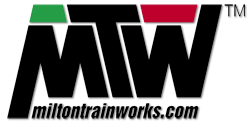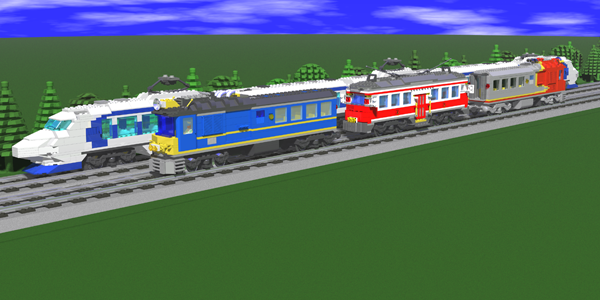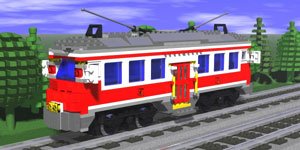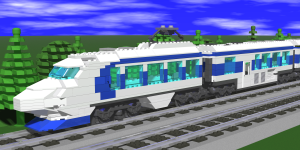
|
Milton Train Works™Custom kits and custom models |
A proud member of |

|
|
|
This is the complete collection of MTW passenger equipment. Front and center, the red and white “PCC” streetcar, MTW-3001. Bracketing the PCC are two versions of the MTW-3002 “Doodlebug”. On the rear track is the train that stopped a school, the original Bullet Train, modeled after an early Shinkasen of Japan Railways. |
One of a series of instruction CDs from Milton Train Works™, this CD gives you everything you need to build your own copy of both of MTW's great passenger models, plus more! You get it all... except the parts.
The instructions and images were created with MLCad, an LDraw compatible CAD modeling program especially designed for use with LEGO® and compatible elements, and rendered with LDLite and POVray. Enjoy!
Just look at everything you get in this CD:
More info on all the models on this CD:
 MTW-3001-rw
PCC Streetcar
MTW-3001-rw
PCC Streetcar
The sharp custom red and white “PCC” streetcar, MTW-3001, is the first powered model ever sold to the collecting public by custom kit builders. It’s modeled after a mid 20th century US prototype streetcar or interurban.
I've styled it to resemble a PCC car of the 30’s. I'm not claiming it's a completely accurate depiction, even within the limits of the LEGO® medium. But it looks good and it runs well.
Read the review by Arnold Chang (from 2002).
 Complete instructions in PDF format.
Complete instructions in PDF format.
 Step by step parts list in PDF format.
Step by step parts list in PDF format.
For more information on this model, you can view the MTW-3001 product page (opens a new page)
 MTW-3002-bu
Doodlebug Gas Electric Railcar
MTW-3002-bu
Doodlebug Gas Electric Railcar
This handsome custom design builds a mid 20th century US prototype Gas Electric railcar. It does not follow any specific prototype but I was trying for the much beloved Doodlebug look.
First developed in the early 20th century to replace expensive steam passenger trains, these were important because their early development (in the teens and twenties) led several of these manufacturers (notably GE and EMC) to try their hand at diesels based on what they learned. And the diesel is arguably the most important railroading development of the 20th century. But that's not why I did one. It’s because they're so darn cute!
 Complete instructions in PDF format.
Complete instructions in PDF format.
 Step by step parts list in PDF format.
Step by step parts list in PDF format.
For more information on this model, you can view the MTW-3002 product page (opens in a new window)
 Bonus:
MTW-3002-ATSF variant Bug
Bonus:
MTW-3002-ATSF variant Bug
Inspired by the ATSF "Super Chief" F unit model that LEGO introduced in 2002, I developed this doodlebug variant just for fun, and to pay homage to my favorite railroad, the Atchison, Topeka and Santa Fe Railway, now merged into BNSF. My personal copy has the stickers from a copy of the ATSF model but those are getting hard to find.
Here's are some prototype pictures: M-190 (courtesy of Railfan.net ABPR Image Archives) and M-119 (courtesy of Wikimedia Commons), and here's a model, courtesy of girr.org.
 MPD source file suitable for use with MLCad or other LDraw compatible programs (see below)
MPD source file suitable for use with MLCad or other LDraw compatible programs (see below)
 Bonus:
Shinkansen Bullet Train
Bonus:
Shinkansen Bullet Train
I've long been taken with fast trains, and the Shinkansen is certainly among the fastest. We call this model, styled after an early Shinkasen of Japan Railways, "the train that stopped a school".
When my son Nik, then in second grade, announced that his class was doing a project on Japan and he'd chosen to report on Bullet Trains, and was planning to build a model, I thought that was pretty neat. You can guess who actually built it, though! Well, it turned into "the train that stopped a school". When we brought it in to show off, it was set up in the hall, and all the other classes milled about to look at it... to the point that we were asked to take it down again, as it was too disruptive! It’s been a crowd pleaser at train shows ever since.
This model is based on parts from 2 copies of LEGO's 4561 Railway Express set, a not very loved set at the time (2000) which is now getting fairly pricey, but you should be OK if you have a reasonable collection. I have run my personal copy at just about every train show I've been to in the last 10 years and it's a good runner. It's fallen to the floor a few times but always goes back together again. Crowds love it too. I hope you enjoy it.
 MPD source file suitable for use with MLCad or other LDraw compatible programs (see below)
MPD source file suitable for use with MLCad or other LDraw compatible programs (see below)
Instructions and parts lists for models, where supplied, are saved as Adobe PDF files. You will need a reader installed to read these. Almost everyone already has Adobe reader installed but in case you do not a free copy can be obtained at Adobe and you can then have PDFs opened automatically. PDF is a widely used format but allows distribution of read-only (not easily editable) copies.
Some models are supplied in source form, meaning that you get the LDraw format source file for the design. This may have an .ldr, .dat. or .mpd extension. To view the design you will need to have an LDraw reader or editor, as well as a recent LDraw parts library, installed. This is discussed in more detail at the www.LDraw.org site in the "getting started" section.
So you need to get the parts library, and a package for your platform. (note, some packages may come with the parts library embedded)
Please visit www.MiltonTrainWorks.com for more information.
Copyright © 1998–2010 — Milton Train Works, Larry Pieniazek. As a CD purchaser, you have the right to make use of these models for your personal use and enjoyment, but all other rights, including but not limited to redistribution rights, are reserved.